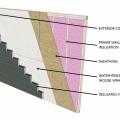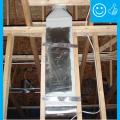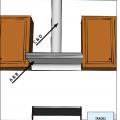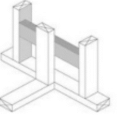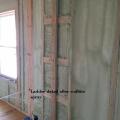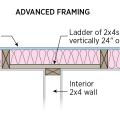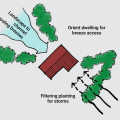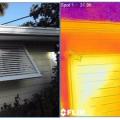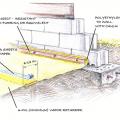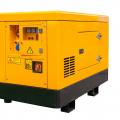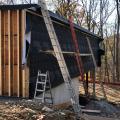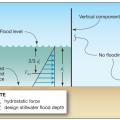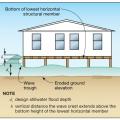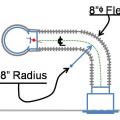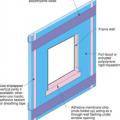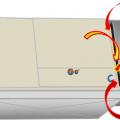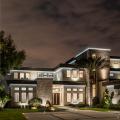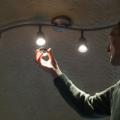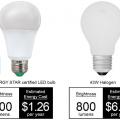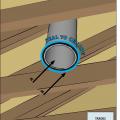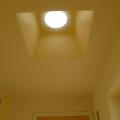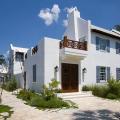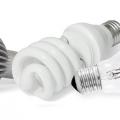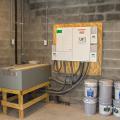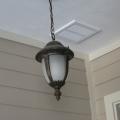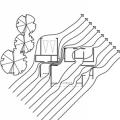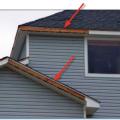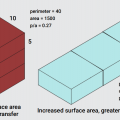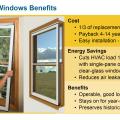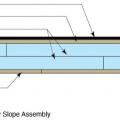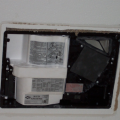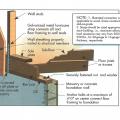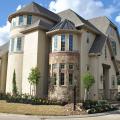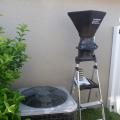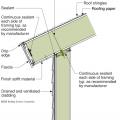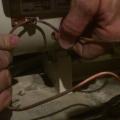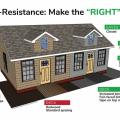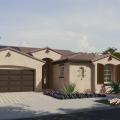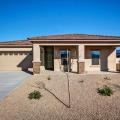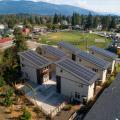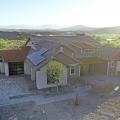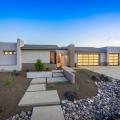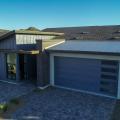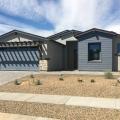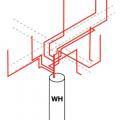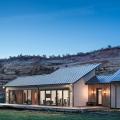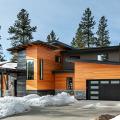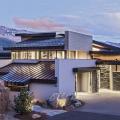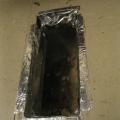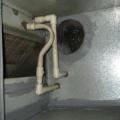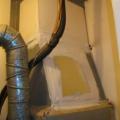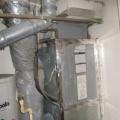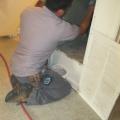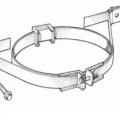Showing results 1801 - 1900 of 4973
Kickout diverter flashing keeps bulk water from the roof from overflowing the gutter and continuously wetting the siding material.
Knee braces do not stiffen a pile foundation as much as diagonal bracing, but they present less obstruction to waves and debris, are less prone to compression buckling, and may be designed for both tension and compression loads.
Lack of insulation over the top plate can lead to ice dam formation on a low sloped roof.
Ladder blocking where exterior walls intersect interior walls provides more space for insulation and reduces thermal bridging.
Ladder blocking where interior and exterior walls intersect uses less wood and provides more room for insulation than stacking studs in the exterior wall to nail the interior wall to.
Landscape trees and shrubs to funnel cooling breeze towards a home in hot climate zones.
Landscaping and Bahama shutters can provide important shade for a designated cool room
Large deciduous trees provide heat-blocking shade to the walls and windows of this house.
Larsen trusses made of 9-inch I joists, set perpendicular to the exterior wall at 16 inches on center, provide a second wall cavity that can be filled with blown insulation, greatly increasing the insulation value in the walls.
Lay out duct so that no radius of a bend or turn is less than the diameter of the airway
Lay out the rigid foam sheathing joints so they do not align with the window and door edges
Leading Force Contracting Services and Vista Homes built this custom spec home in the cold climate in Selah, WA, and certified it to DOE Zero Energy Ready Home specifications in 2018.
Leading Force Contracting Services built this custom for buyer home in the cold climate in Selah, WA, and certified it to DOE Zero Energy Ready Home specifications in 2020.
Leaks at the air filter cover panel can draw in unconditioned or undesirable air
Leave the soil level around an existing trunk as is (left); do not increase soil height (center) or remove soil in the root zone (right).
LED interior and exterior lighting makes a stunning display without a big energy penalty.
Ledger board, metal brackets, and vertical 2x4s have been installed in preparation for exterior spray foam in this retrofit exterior wall insulation technique
LEDs are especially efficient in fixtures that send light in one direction, like track lighting
LEDs cut energy costs by using less watts to produce the same amount of light as other light sources.
LifeStyle Homes built custom for buyer home in the cold climate in Downer's Grove, IL, and certified it to DOE Zero Energy Ready Home specifications in 2019.
Lifestyle Homes built this custom spec home in the hot-humid climate in Melbourne, FL, and certified it to DOE Zero Energy Ready Home specifications in 2016.
Lifting plates attached to the wall provide good bracing to tighten up SIP panel seams
Light colors have been used on exterior walls and roofs to keep buildings cooler in hot climates for centuries, as shown by this traditional building in Morocco, built in the early 1800s
Light tubes adjacent to unconditioned space include lens separating unconditioned and conditioned space and are fully gasketed
Light tubes are installed in hallways and closets to bring natural daylight into the home, even in areas that do not have direct windows.
Light-colored roofs and walls and deep overhangs for shade are some of the features used by builders in the hot-humid climate (Source: Alys Beach Construction).
Likely amount of time and radiant heat exposure at which different types of window glass would break at 30 feet from the edge of a wildfire.
Limited attic access can make inspections for missing air barriers and insulation challenging
Limited attic access may make it necessary to use a bore scope when inspecting for missing air barriers and insulation in existing buildings.
Lithium-ion batteries charged by the solar photovoltaic panels provide 200 amperes of standby electricity to critical circuits in case of power failure due to severe weather conditions.
Locate the fresh air intake away from pollution sources and in an easily accessible location
Locating windows on adjacent and opposite sides of the house will allow cross ventilation regardless of wind direction
Location of Braced Wall Panels and Braced Wall Lines, Figure R602.10.2.2 in the IRC
Look for this EPA WaterSense logo to find fixtures that meet WaterSense criteria.
Lopez Community Land Trust built this affordable home in the cold climate in Lopez Island, WA, and certified it to DOE Zero Energy Ready Home specifications in 2021.
Loss of the fascia cover in high winds exposes the vinyl soffit to entry by wind-driven rain.
Low perimeter to area (P/A) ratio home designs reduce heat transfer and perform better in hot climate zones than high P/A ratio homes.
Low-E storm windows are a cost-effective retrofit that is easy to install and can cut heating and cooling bills 10% to 33%.
Low-slope roof assemblies constructed of two deck sheathing layers sandwiching rigid foam, and topped with mechanically fastened membrane
Lower-cost local ERVs are usually installed in a ceiling to supply outdoor air to and exhaust air from the room in which they are located
Lower-story wall anchorage to masonry (or concrete) base. Straps properly nailed at wall studs.
M Street Homes built this production home in the hot-humid climate in Houston, TX, and certified it to DOE Zero Energy Ready Home specifications in 2014.
Make sure the beads of caulk are continuous the full length at each SIP panel seam, such as at the wall-roof seam, to maintain air barrier continuity
Make sure the ground bonding wire is securely fastened to the pump’s bonding lug
Manatee County Habitat for Humanity built this affordable home in the hot-humid climate in Bradenton, FL, and certified it to DOE Zero Energy Ready Home specifications in 2013.
Manatee County Habitat for Humanity trains its volunteers to construct homes made of construct insulated concrete forms (ICFs).
Mandalay Communities built this production home in the mixed-humid climate in Prescott Valley, AZ, and certified it to DOE Zero Energy Ready Home specifications in 2020.
Mandalay Homes built this affordable home in the hot-dry climate in Phoenix, AZ, and certified it to DOE Zero Energy Ready Home specifications in 2013.
Mandalay Homes built this affordable home in the hot-dry climate in Phoenix, AZ, and certified it to DOE Zero Energy Ready Home specifications in 2018.
Mandalay Homes built this custom spec home in the marine climate in Sedro Wooley, WA, and certified it to DOE Zero Energy Ready Home specifications in 2021.
Mandalay Homes built this production home in the hot-dry climate in Wickenburg, AZ, and certified it to DOE Zero Energy Ready Home specifications in 2018.
Mandalay Homes built this production home in the mixed-dry climate in Glendale, AZ, and certified it to DOE Zero Energy Ready Home specifications in 2015.
Mandalay Homes built this production home in the mixed-dry climate in Pheonix, AZ, and certified it to DOE Zero Energy Ready Home specifications in 2014.
Mandalay Homes built this production home in the mixed-dry climate in Prescott, AZ, and certified it to DOE Zero Energy Ready Home specifications in 2016.
Mandalay Homes built this production home in the mixed-dry climate in Prescott, AZ, and certified it to DOE Zero Energy Ready Home specifications in 2019.
Mandalay Homes built this production home in the mixed-dry climate in Prescott, AZ, and certified it to DOE Zero Energy Ready Home specifications in 2017.
Mandalay Homes built this production home in the mixed-dry climate in Prescott, AZ, and certified it to DOE Zero Energy Ready Home specifications in 2021.
Mandalay Homes uses information displays, equipment displays, an interactive “energy wall,” equipment modeling, and building deconstruction displays in its model homes and sales offices.
Mantell-Hecathorn Builders built this custom for buyer home in the cold climate in Durango, CO, and certified it to DOE Zero Energy Ready Home specifications in 2016.
Mantell-Hecathorn Builders built this custom for buyer home in the cold climate in Durango, CO, and certified it to DOE Zero Energy Ready Home specifications in 2020.
Mantell-Hecathorn Builders built this custom for buyer home in the cold climate in Durango, CO, and certified it to DOE Zero Energy Ready Home specifications in 2017.
Mantell-Hecathorn Builders built this custom for buyer home in the cold climate in Durango, CO, and certified it to DOE Zero Energy Ready Home specifications in 2019.
Mantell-Hecathorn Builders built this custom home in the cold climate in Durango, CA, and certified it to DOE Zero Energy Ready Home specifications in 2015.
Manual D details show duct size and chase path
Many hardware stores sell appliance bracing kits to secure the water heater to wall framing with metal straps
